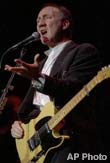Sound Science: Pete Townshend Blames Headphones for Hearing Loss

In a widely reported story this week, rock star Pete Townshend blamed his hearing loss on earphones rather than the years of participating in loud concerts with his band, The Who.
But what is the science of his claim? Pretty solid.
Townshend has spoken of his hearing loss before but refrained from blaming headphones or speaking to the science of the situation. But having been forced to alter the style of music he writes, as well as needing to take 36-hour breaks from the noise, he felt compelled to break the silence.
"This very morning, after a night in the studio trying to crack a difficult song demo, I wake up realizing again—reminding myself, and feeling the need to remind the world—that my own particular kind of damage was caused by using earphones in the recording studio, not playing loud on stage," Townshend wrote on his web site Dec. 29.
"My ears are ringing, loudly," the guitarist wrote. "This rarely happens after a live show, unless the Who play a small club. This is a peculiar hazard of the recording studio."
The science of it
Warnings about potential hearing loss from loud concert music go back decades. Researchers in the 1980s began cautioning that the Walkman and other headphone-based music devices also packed risk.
Get the world’s most fascinating discoveries delivered straight to your inbox.
The widespread and increasing use of headphones and the newer earbuds has been shown to induce hearing loss in young people.
An updated warning was issued just last month for the modern devices, including iPods and MP3 players.
"We're seeing the kind of hearing loss in younger people typically found in aging adults," Dean Garstecki, a Northwestern University audiologist, said in December. "Unfortunately, the earbuds preferred by music listeners are even more likely to cause hearing loss than the muff-type earphones that were associated with the older devices."
Earbuds, being inserted into rather than surrounding it, can boost sound intensity by 6 to 9 decibels, Garstecki said.
What hurts
Hearing loss is typically painless and gradual in its inception. So we don't notice it's early stages, except perhaps as a ringing in the ear known as tinnitus.
The American Hearing Research Foundation (AHRF) reports that "1-in-10 Americans has a hearing loss that affects his or her ability to understand normal speech."
The decibel (dB) scale is logarithmic, such that 40 decibels is 100 times as intense as 20 decibels. Some common sounds:
- 20 dB: A whisper
- 60 dB: Normal conversation
- 100 dB: Chainsaw
- 120 dB: Rock concert
- 140 dB: Jet engine
- 180 dB: Firecracker
Length of exposure is a crucial factor in hearing loss. A constant 100-dB sound level can cause damage after 2 hours, according to the AHRF. You don't want to experience 140 dB for even a second.
Earbud exposure
Students at Witchita State University have been found to be experiencing decibel levels of 110 to 120 during normal use of earbuds, Garstecki said.
He fears that better batteries nowadays make personal music players even more dangerous, because people can use them for long stretches. He recommends reducing the sound level and limiting use to an hour a day to stay safe.
Townshend, while not a scientist, also worries about extended use, because music is so often shared among computers in offices and kitchens, and headphones offer privacy.
"If you use an iPod or anything like it, or your child uses one, you MAY be OK," Townshend writes. "It may only be studio earphones that cause bad damage. I only have long experience of the studio side of things (though I've listened to music for pleasure on earphones for years, long before the Walkman was introduced). But my intuition tells me there is terrible trouble ahead."
Robert is an independent health and science journalist and writer based in Phoenix, Arizona. He is a former editor-in-chief of Live Science with over 20 years of experience as a reporter and editor. He has worked on websites such as Space.com and Tom's Guide, and is a contributor on Medium, covering how we age and how to optimize the mind and body through time. He has a journalism degree from Humboldt State University in California.

